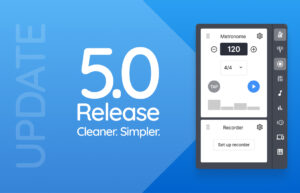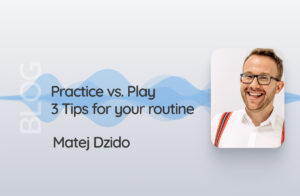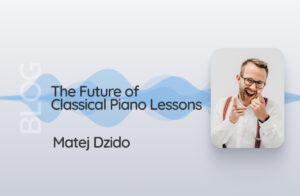by José J. Cortijo
In my opinion, one of the main goals of music education should be to teach students to play on existing music as soon as possible. In order to be able to play with a band or in an ensemble, they must first reach a certain theoretical and technical level on their instruments. But how do you work effectively with play-alongs in music lessons?
With the use of play-alongs in the classroom, even a beginner can learn to play to music. Similar to a band, you can play passages at an adapted speed or play difficult passages in a loop.
A Loop is Music, Too
It is important to understand that playing to play-alongs does not always mean a complete song, but also fragments or loops of them. In this form, play-alongs can be regarded and used as a “musical metronome”, so to speak.
Playing to play-alongs is also a very important and helpful method outside of band or orchestra practice to analyze and learn one’s instrument in a musical context within their own – without external pressure.
In my opinion, every music lesson should contain a unit in which music is “practiced”, regardless of whether the lesson was “only” about technique, posture, theory or other topics. This can be done quickly with playalongs.
Does Technique Have to be “Monotonous Stuff”?
Every exercise, no matter how unpopular, can be more fun and motivating for the students if it is played and worked on to music instead of to the metronome.
Playing to play-alongs can be applied to various practice topics. “Monotonous”, technical exercises, such as the so-called rudiments on the drums or scales, take on a completely different character. At the same time, the relationship of the exercise to the music can be explored and made conscious.
Especially for accompanying instruments like drums or percussion, play-alongs are indispensable, because besides timing, the application as well as the interpretation of the learned rhythms must be worked out in the musical context of the song or rhythm. This also prepares the students for later band rehearsals.
There Will Always Be a Recording Situation to Prepare to

Another aspect that can be worked on when practising with play-alongs is the simulation of recording situations. Not only do you have to play along with pre-recorded songs, but you also have to listen to your instrument through the microphones in your headphones. This is a highly complex and new situation for anyone who plays an instrument. Your own instrument suddenly sounds different from what you are used to. At the same time, you can’t see your band mates and have to rely completely on your ear.
In principle, this situation already takes place during online lessons via doozzoo, when the students play with headphones in sync with the audio player. They can also record themselves playing at any time.
My Own Way of Working
Depending on the level of difficulty, I use a slightly different method. For example, before we start playing a new rhythm or a solo to an instrumental playback, I go through the following steps:
Learning the new feeling
In Latin percussion, for example, the first step is to introduce the student to the new rhythm. I play the rhythm a few times. Then I ask if he or she has heard the rhythm before. Are the name and origin familiar? From which country does the rhythm come? In what music is it used? I often show the student videos in which the rhythm can be seen and heard. This gives the students a feeling for the sound and the corresponding movements.
Slowly build up the rhythm
Next, I start to build up the rhythm slowly. I don’t use sheet music yet. First, half a bar of the rhythm is played several times together (only possible in presence) or one after the other (possible online and in presence) and repeated. When everything is played smoothly and without mistakes, the rest of the bar is added. Percussion rhythms often consist of two-bar phrases. Here, the second bar is built up and practised in the same way until the rhythm is complete. If this works safely, I let the student play alone to the metronome to be able to control the timing properly.
Playing with playalongs
At this point, playalongs are played. Due to the influence of other melodies and polyrhythms, interpretation mistakes happen during the first attempts that may not have happened before. For this reason, I always set a slightly slower tempo in the audio player first. This makes it easier to perceive and understand musical contexts and any other percussion instruments that may be present.
Difficult passages or fills can be set to different tempos with the audio player on doozzoo. They can even be repeated in a loop with the loop function.
Dropping sheet music
If I see that the students are very focused on the notes, I hide the sheet music or take it away. In this way, hearing and concentration are particularly challenged and trained. This allows the student to develop the right feeling for the music and the rhythm and to put it into his or her interpretation.
Buy Or Produce Play-Alongs?
But where can you get good playalongs? For some instruments, there is a large selection of books that come with playalongs. For other instruments, the choice is quite limited. There are, however, a few possibilities to produce your own playalongs or loops for your own lessons with manageable effort.
Tip no. 1 – MIDI-Files or Mp3 Playbacks
There are numerous free and paid offers for MIDI or mp3 playbacks on the internet. Every genre is available, be it classical, jazz or pop. Most of the time you have the possibility to listen to at least an excerpt of the audio file before you make the purchase. You should take advantage of this, because the differences in quality are very great!
The MIDI file sector is also so large because almost all “one-man entertainers” use these files for their events. The karaoke sector also uses MIDI files.
Furthermore, they can be opened and processed by almost any music program (FINALE, Sibelius, Logic).
Creating play-alongs for drums
Next, I would like to show you a way to create a play-along for drums. This method can also be used for all other instruments:
- Download the song as a MIDI file. But now the drums are still there.
- Now open the MIDI file with a notation programme, e.g. Finale. In the score we can now also find the drum notes.
- Now delete the drum notes from the score, but not the staff itself!
- If there is no count-in, you can insert one or two bars at the beginning of the sheet music. A cowbell or rim click is suitable as a sound. The count-in is noted on the empty staff.
- Now export everything using the export function of the notation program. Use mp3 as format.
- Now load the finished play-along into your doozzoo media library and let your students play it.
Most MIDI files sound rather mechanical and artificial. But you can change this with a few simple steps, because the file format can be edited in the usual programmes.
Here are a few tips for customising MIDI files:
- Replace the sound and use your own
- Change the arrangement
- Transpose instruments to a different position
- Create a continuous click track
- Use effects (e.g. reverb, compressor, equalizer, etc.)
- Adjust the volume of the individual instruments
- Distribute the instruments in the stereo image by means of panorama
- Mute individual instruments
Tip no. 2 – Loops
Many live musicians use audio programmes like Logic, Ableton-Live & Co. Most of them come with a library of ready-to-use loops. These can and may be edited and used. Use these loops to work on solo figures or to repeat technical exercises with your students.
Summary
In summary, playing to play-alongs is an important part of my teaching. It teaches skills that students can otherwise only learn with a tape or in a recording situation. At the same time, it prepares them optimally for both. They learn not only to listen to themselves while playing, but also to embed themselves sonically in a (virtual) band. I personally recommend every teacher to use this possibility, especially because it can be used so creatively in teaching.
About the author

As the only professor of Latin percussion in Germany, José J. Cortijo teaches at the Mannheim State University of Music and Performing Arts and is a sought-after lecturer at numerous workshops in Germany and abroad.
He is also the author of various publications and a workshop series in the professional journal Drums & Percussion, artistic director of the World Percussion Academy and the Cajon Academy.
In addition to performing with his own projects, José J. Cortijo also takes part in many tours of well-known artists from Germany and abroad. The spectrum ranges from Latin, funk, pop and rock to big bands and musicals.











